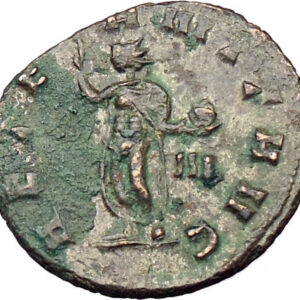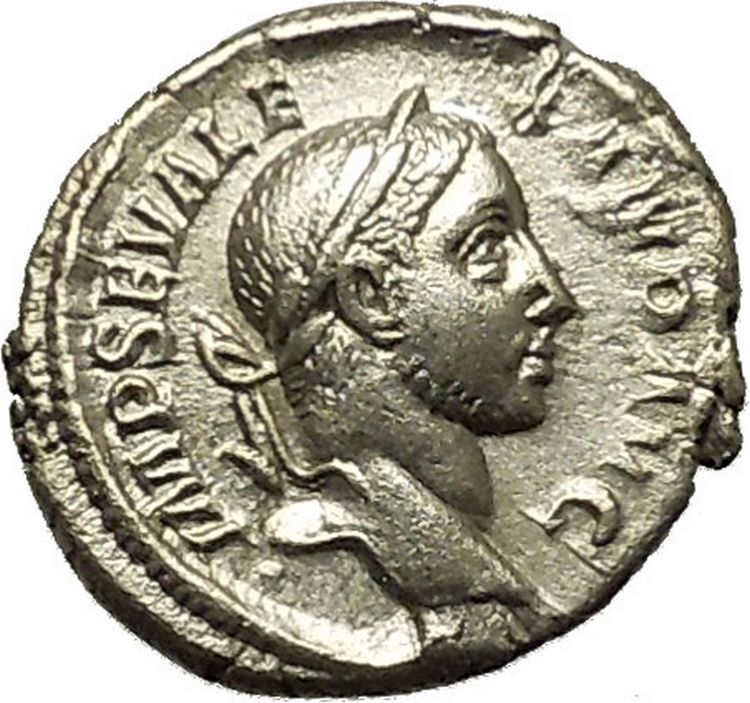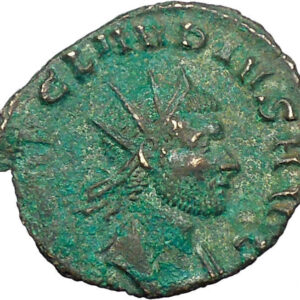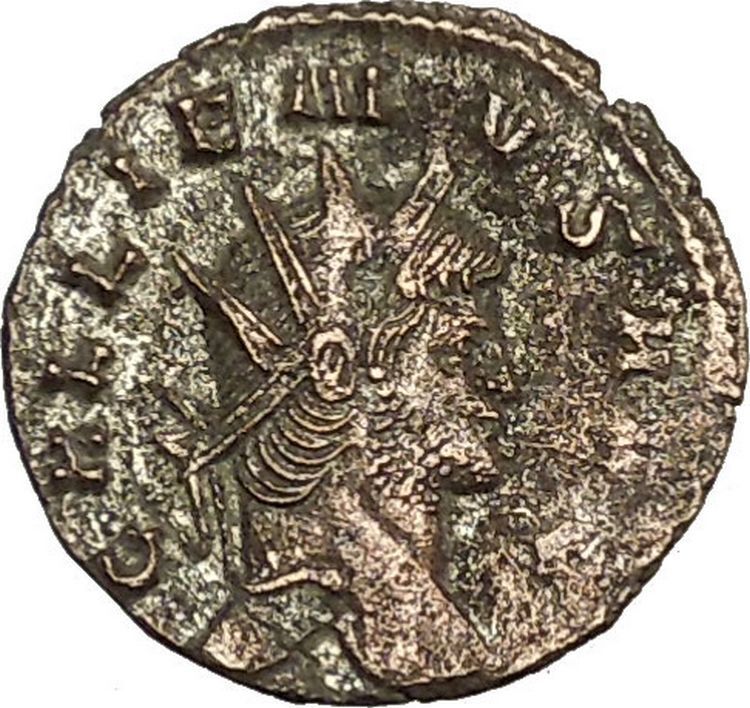|
Hadrian
–
Roman Emperor
: 117-138 A.D. –
Bronze As 27mm (6.67 grams) Struck at the mint of Rome 124-128 A.D.
Reference: RIC 678, BMC 1349, S 3692, C 1357
HADRIANVSAVGVSTVS – Laureate head right.
SALVSAVGVSTI Exe: COSIII –
Salus standing left, feeding snake (from patera) on altar.
SC across fields.
You are bidding on the exact item pictured,
provided with a Certificate of Authenticity and Lifetime Guarantee of
Authenticity.
In the
material culture
of
classical antiquity
, a phiale or
patera (Latin pronunciation: [ˈpatera])
is a shallow ceramic or metal
libation
bowl. It often has a bulbous
indentation (omphalos,
“bellybutton”) in the center underside to facilitate holding it, in which case
it is sometimes called a mesomphalic phiale. It typically has no handles,
and no feet. (A drinking cup with handles is a
kylix
. A circular platter with a pair of
C-handles is not a patera, but a few paterae have a single long straight
handle.) Although the two terms may be used interchangeably, particularly in the
context of
Etruscan culture
, phiale is more common
in reference to Greek forms, and patera in a Roman setting.
-
Silver phiale (620-590 BC, from
Bayindir
village,
Elmali
, present-day Turkey
-
Octopus and dolphin motifs on a ceramic phiale (510–500 BC, from
Eretria
,
Euboea
)
-
Golden phiale (4th–3rd century BC)
-
Silver patera from
Hispania
(Roman
Spain), 2nd–1st century BC)
Use

A youth pours a libation to the deceased within a
naiskos
, a scene that may also
represent
Ganymede
serving
Zeus
( Apulian
red-figure
krater
, 340–320 BC)
Libation was a central and vital aspect of
ancient Greek religion
, and one of the simplest
and most common forms of religious practice. It is one of the basic religious
acts that define piety in ancient Greece, dating back to the
Bronze Age
and even
prehistoric Greece
. Libations were a part of
daily life, and the pious might perform them every day in the morning and
evening, as well as to begin meals. A libation most often consisted of mixed
wine and water, but could also be unmixed wine, honey, oil, water, or milk.
The form of libation called spondē is typically the ritualized pouring
of wine from a jug or bowl held in the hand. The most common ritual was to pour
the liquid from an
oinochoē
(wine jug) into a phiale. Libation
generally accompanied prayer. The Greeks stood when they prayed, either with
their arms uplifted, or in the act of libation with the right arm extended to
hold the phiale. After the wine offering was poured from the phiale, the
remainder of the contents was drunk by the celebrant.
In Roman art
, the libation is shown performed at
an
altar, mensa (sacrificial meal table)
,
or
tripod
. It was the simplest form of sacrifice,
and could be a sufficient offering by itself. The introductory rite (praefatio)
to an animal sacrifice included an incense and wine libation onto a burning
altar. Both
emperors
and divinities are frequently
depicted, especially on coins, pouring libations from a patera. Scenes of
libation and the patera itself commonly signify the quality of
pietas
, religious duty or reverence.
-
Libation at a
symposium
(Attic
red-figure cup, ca. 480 BC)
-
Apollo pouring a libation (Attic
white-ground
kylix
, ca. 460 BC)
-
Etruscan priest with phiale (2nd century BC)
-
Roman priest,
capite velato
(2nd–3rd century
AD)
In
Greek
and
Roman mythology
, Hygieia (also Hygiea
or Hygeia, Greek Ὑγιεία or
Ὑγεία, Latin Hygēa or Hygīa),
was the daughter of the god of medicine,
Asclepius
, and
Epione
. She was the goddess/personification of
health, cleanliness and sanitation.
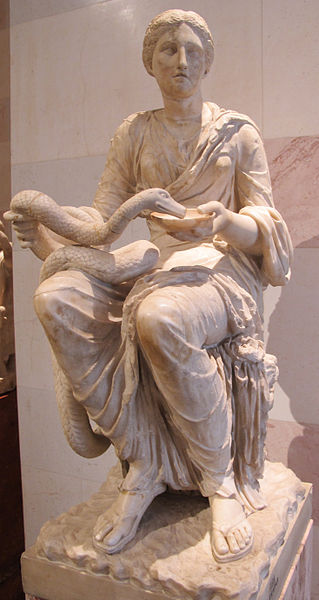
Hygieia
and her five sisters each performed a facet of
Apollo
‘s art: Hygieia (“Hygiene” the
goddess/personification of health, cleanliness, and sanitation),
Panacea
(the goddess of Universal remedy),
Iaso (the goddess of recuperation from illness),
Aceso
(the goddess of the healing process).
Hygieia also played an important part in her father’s
cult
. While her father was more directly
associated with healing, she was associated with the prevention of sickness and
the continuation of good health. Her name is the source of the word “hygiene“.
She was imported by the Romans as the Goddess Valetudo, the goddess of personal
health, but in time she started to be increasingly identified with the ancient
Italian goddess of social welfare,
Salus
.
History
At Athens, Hygieia was the subject of a local cult since at least the 7th
century BC. “Athena Hygieia” was one of the cult titles given to
Athena
, as Plutarch recounts of the building of
the Parthenon
(447-432 BC):
|
“ |
A strange accident happened in the course of building, which showed that
the goddess was not averse to the work, but was aiding and co-operating
to bring it to perfection. One of the artificers, the quickest and the
handiest workman among them all, with a slip of his foot fell down from
a great height, and lay in a miserable condition, the physicians having
no hope of his recovery. When Pericles was in distress about this, the
goddess [Athena] appeared to him at night in a dream, and ordered a
course of treatment, which he applied, and in a short time and with
great ease cured the man. And upon this occasion it was that he set up a
brass statue of Athena Hygieia, in the citadel near the altar, which
they say was there before. But it was
Phidias
who wrought the goddess’s image
in gold, and he has his name inscribed on the pedestal as the workman of
it. |
” |
However, the cult of Hygieia as an independent goddess did not begin to
spread out until the
Delphic oracle
recognized her, and after the
devastating
Plague of Athens
(430-427 BC) and in Rome in
293 BC.
In the 2nd century AD,
Pausanias
noted the statues both of Hygieia and
of Athena Hygieia near the entrance to the
Acropolis
of Athens.
Worship
Hygieia’s primary temples were in
Epidaurus
,
Corinth
,
Cos
and Pergamon
.
Pausanias
remarked that, at the Asclepieion
of Titane
in
Sicyon
(founded by
Alexanor
, Asclepius’ grandson), statues of
Hygieia were covered by women’s hair and pieces of
Babylonian
clothes. According to inscriptions,
the same sacrifices were offered at
Paros
.
Ariphron
, a Sicyonian artist from the 4th
century BC wrote a well-known
hymn celebrating her. Statues of Hygieia were created by
Scopas
,
Bryaxis
and
Timotheus
, among others, but there is no clear
description of what they looked like. She was often depicted as a young woman
feeding a large snake that was wrapped around her body or drinking from a jar
that she carried. These attributes were later adopted by the
Gallo-Roman
healing goddess,
Sirona
. Hygieia was accompanied by her brother,
Telesphorus
.
The
Pythagoreans
called the pentagram ὑγιεία Hugieia (“health”); also the Greek goddess of
health, Hygieia
and saw in the pentagram a mathematical perfection.
Salus (Health) a Goddess of the Romans, the same that was worshipped under
the name of Hygiea by the Greeks, who feigned her to be the daughter of
Asclepius and of Minerva. On a denarius of the Acilia family appears the head
of the goddess and on the reverse a female standing with a serpent in her hand.
The types of this divinity on imperial coins most frequently present to view a
woman clothed in the stola;  sometimes sometimes
she is sitting, at others standing; in others in a recumbent posture, with a
serpent either on her right or her left arm in a quiescent state, rising in
folds or entwined round an altar before her, and receiving food from a patera,
which she holds in her extended hand. It is in this form (which was doubtless
that of her statues and with these symbols) that she is exhibited on most coins
on the imperial series from Galba to Maximianus. She had a celebrated temple at
Rome, painted, it was said, by Q. Fabius, who thence was surnamed Pictor (the
painter) . – There appears to be some affinity between this personification of
Salus, when offering food in a patella to a serpent, and the Lanuvian virgin
represented in the same act on coins bearing the head of Juno Sospita. – The
opinion also has the probability on the face of it, which refers the serpent on
coins, where mention is made of Salus Augusti, or Augustorum, to Aesculapius and
his daughter Hygaeia (or Salus) as deities of Health. – Certain it is that when
those sanitary divinities, and especially when Dea Salus, occur on coins of
Emperors, they indicate that those princes were labouring at the time under some
diseases; on which account, it would seem, sacred rites had been performed for
them and the memorial of the event recorded on public monuments
 Publius Aelius Hadrianus Publius Aelius Hadrianus
(as emperor Imperator Caesar Divi Traiani filius Traianus Hadrianus Augustus,
and Divus Hadrianus after his
apotheosis
,
known as Hadrian in
English
; 24 January 76 – 10 July 138) was
emperor
of
Rome
from AD 117 to 138, as well as a
Stoic
and
Epicurean
philosopher. A member of the
gens
Aelia
,
Hadrian was the third of the so-called
Five Good Emperors
.
Hadrian was born Publius Aelius Hadrianus in
Italica
or, less probably, in Rome
,
from a well-established family which had originated in
Picenum
in
Italy
and had
subsequently settled in
Italica
,
Hispania Baetica
(the republican
Hispania
Ulterior), near the present day location of Seville, Spain. His predecessor
Trajan
was a
maternal cousin of Hadrian’s father.
Trajan never officially designated a successor, but, according to his wife,
Pompeia Plotina
, Trajan named Hadrian emperor immediately before his death.
Trajan’s wife was well-disposed toward Hadrian: Hadrian may well have owed his
succession to her.
Hadrian’s presumed indebtedness to Plotina was widely regarded as the reason
for Hadrian’s succession. However, there is evidence that he accomplished his
succession on his own governing and leadership merits while Trajan was still
alive. For example, between the years AD 100–108 Trajan gave several public
examples of his personal favour towards Hadrian, such as betrothing him to his
grandniece,
Vibia
Sabina
, designating him quaestor Imperatoris, comes Augusti,
giving him Nerva’s diamond “as hope of succession”, proposing him for consul
suffectus, and other gifts and distinctions. The young Hadrian was Trajan’s
only direct male family/marriage/bloodline. The support of Plotina and of
L. Licinius Sura
(died in AD 108) were nonetheless extremely important for
Hadrian, already in this early epoch.
Early
life
Although it was an accepted part of Hadrian’s personal history that Hadrian
was born in Italica
located in the province called
Hispania Baetica
(the southernmost Roman province in the
Iberian Peninsula
, comprising modern
Spain
and
Portugal
),
his biography in
Augustan History
states that he was born in Rome on 24 January 76 of a
family originally Italian,
but Hispanian for many generations. However, this may be a ruse to make Hadrian
look like a person from Rome instead of a person hailing from the provinces.
His father was the Hispano-Roman
Publius Aelius Hadrianus Afer
, who as a
senator
of praetorian
rank would spend much of his time in Rome.
Hadrian’s forefathers came from Hadria, modern
Atri
,
an ancient town of Picenum in Italy, but the family had settled in
Italica
in
Hispania Baetica soon after its founding by
Scipio Africanus
. Afer was a paternal cousin of the future Emperor
Trajan
. His
mother was Domitia
Paulina
who
came from Gades (Cádiz).
Paulina was a daughter of a distinguished Hispano-Roman Senatorial family.
Hadrian’s elder sister and only sibling was Aelia Domitia
Paulina
,
married with the triple consul
Lucius Julius Ursus Servianus
, his niece was Julia Serviana
Paulina
and
his great-nephew was Gnaeus Pedanius Fuscus Salinator, from
Barcino
. His
parents died in 86 when Hadrian was ten, and the boy then became a ward of both
Trajan and
Publius Acilius Attianus
(who was later Trajan’s Praetorian Prefect).
Hadrian was schooled in various subjects particular to young
aristocrats
of the day, and was so fond of learning
Greek
literature that he was nicknamed Graeculus (“Greekling”).
Hadrian visited
Italica
when
(or never left it until) he was 14, when he was recalled by Trajan who
thereafter looked after his development. He never returned to Italica although
it was later made a
colonia
in his honour.
His first military service was as a
tribune
of
the
Adiutrix Legio II
. Later, he was to be transferred to the
Minervia Legio I
in
Germany
. When
Nerva
died in 98,
Hadrian rushed to inform Trajan personally. He later became
legate
of a
legion
in Upper Pannonia
and eventually governor of said province. He was also
archon
in
Athens
for a
brief time, and was elected an Athenian citizen.
His career before becoming emperor follows: decemvir stlitibus iudicandis
– sevir turmae equitum Romanorum – praefectus Urbi feriarum Latinarum
– tribunus militum legionis II Adiutricis Piae Fidelis (95, in Pannonia
Inferior) – tribunus militum legionis V Macedonicae (96, in Moesia
Inferior) – tribunus militum legionis XXII Primigeniae Piae Fidelis (97,
in Germania Superior) – quaestor (101) – ab actis senatus –
tribunus plebis (105) – praetor (106) – legatus legionis I
Minerviae Piae Fidelis (106, in Germania Inferior) – legatus Augusti pro
praetore Pannoniae Inferioris (107) – consul suffectus (108) –
septemvir epulonum (before 112) – sodalis Augustalis (before 112) –
archon Athenis (112/13) – legatus Syriae (117).
Hadrian was active in the wars against the
Dacians
(as
legate of the
Macedonica V
) and reputedly won awards from Trajan for his successes.
Due to an absence of military action in his reign, Hadrian’s military skill is
not well attested; however, his keen interest and knowledge of the army and his
demonstrated skill of administration show possible strategic talent.
Hadrian joined Trajan’s expedition against Parthia as a legate on Trajan’s
staff.
Neither during the initial victorious phase, nor during the second phase of the
war when rebellion swept Mesopotamia did Hadrian do anything of note. However
when the governor of
Syria
had to be sent to sort out renewed troubles in Dacia, Hadrian was
appointed as a replacement, giving him an independent command.
Trajan, seriously ill by that time, decided to return to Rome while Hadrian
remained in
Syria
to guard the Roman rear. Trajan only got as far as
Selinus
before he became too ill to go further. While Hadrian may have been
the obvious choice as successor, he had never been adopted as Trajan’s heir. As
Trajan lay dying, nursed by his wife, Plotina (a supporter of Hadrian), he at
last adopted Hadrian as heir. Since the document was signed by Plotina, it has
been suggested that Trajan may have already been dead.
Emperor
Securing
power
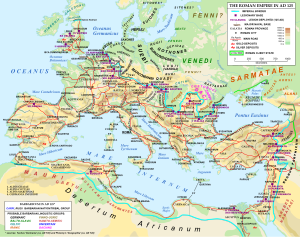
The Roman empire in 125 AD, under the rule of Hadrian.

Castel Sant’Angelo
, the ancient Hadrian
Mausoleum
.

This famous statue of Hadrian in Greek dress was revealed in 2008 to
have been forged in the
Victorian era
by cobbling together a head of Hadrian and an
unknown body. For years the statue had been used by historians as
proof of Hadrian’s love of Hellenic culture.
Hadrian quickly secured the support of the legions — one potential opponent,
Lusius Quietus
, was instantly dismissed.
The Senate’s endorsement followed when possibly falsified papers of adoption
from Trajan were presented (although he had been the ward of
Trajan
). The
rumor of a falsified document of adoption carried little weight — Hadrian’s
legitimacy arose from the endorsement of the Senate and the Syrian armies.
Hadrian did not at first go to Rome — he was busy sorting out the East and
suppressing the Jewish revolt that had broken out under Trajan, then moving on
to sort out the Danube
frontier. Instead, Attianus, Hadrian’s former guardian, was put in
charge in Rome. There he “discovered” a plot involving four leading Senators
including Lusius Quietus and demanded of the Senate their deaths. There was no
question of a trial — they were hunted down and killed out of hand. Because
Hadrian was not in Rome at the time, he was able to claim that Attianus had
acted on his own initiative. According to Elizabeth Speller the real reason for
their deaths was that they were Trajan’s men.
Hadrian
and the military
Despite his own great stature as a military administrator, Hadrian’s reign
was marked by a general lack of major military conflicts, apart from the Second
Roman-Jewish War. He surrendered Trajan’s conquests in
Mesopotamia
, considering them to be indefensible. There was almost a war
with Parthia
around 121, but the threat was averted when Hadrian succeeded in negotiating a
peace.
The peace policy was strengthened by the erection of permanent fortifications
along the empire’s borders (limites,
sl.
limes). The most famous of these is the massive
Hadrian’s Wall
in
Great
Britain
, and the
Danube
and
Rhine
borders
were strengthened with a series of mostly wooden
fortifications
, forts,
outposts
and
watchtowers
, the latter specifically improving communications and local area
security. To maintain morale and keep the troops from getting restive, Hadrian
established intensive drill routines, and personally inspected the armies.
Although his coins showed military images almost as often as peaceful ones,
Hadrian’s policy was peace through strength, even threat.
Cultural
pursuits and patronage
Hadrian has been described, by Ronald Syme among others, as the most
versatile of all the Roman Emperors. He also liked to display a knowledge of all
intellectual and artistic fields. Above all, Hadrian patronized the arts:
Hadrian’s Villa
at Tibur (Tivoli)
was the greatest Roman example of an
Alexandrian
garden, recreating a sacred landscape, lost in large part to the despoliation of
the ruins by the
Cardinal d’Este
who had much of the marble removed to build
Villa
d’Este
. In Rome
,
the Pantheon
, originally built by
Agrippa
but destroyed by fire in 80, was rebuilt under Hadrian in the domed
form it retains to this day. It is among the best preserved of Rome’s ancient
buildings and was highly influential to many of the great architects of the
Italian Renaissance
and
Baroque
periods.
From well before his reign, Hadrian displayed a keen interest in
architecture, but it seems that his eagerness was not always well received. For
example,
Apollodorus of Damascus
, famed architect of the
Forum of Trajan
, dismissed his designs. When
Trajan
,
predecessor to Hadrian, consulted Apollodorus about an architectural problem,
Hadrian interrupted to give advice, to which Apollodorus replied, “Go away and
draw your pumpkins. You know nothing about these problems.” “Pumpkins” refers to
Hadrian’s drawings of domes like the Serapeum in his Villa. It is rumored that
once Hadrian succeeded Trajan to become emperor, he had Apollodorus exiled and
later put to death. It is very possible that this later story was a later
attempt to defame his character, as Hadrian, though popular among a great many
across the empire, was not universally admired, either in his lifetime or
afterward.
Hadrian wrote poetry in both Latin and Greek; one of the few surviving
examples is a Latin poem he reportedly composed on his deathbed (see
below
). He
also wrote an autobiography – not, apparently, a work of great length or
revelation, but designed to scotch various rumours or explain his various
actions. The work is lost but was apparently used by the writer — whether
Marius Maximus
or someone else – on whom the Historia Augusta
principally relied for its vita of Hadrian: at least, a number of
statements in the vita have been identified (by
Ronald
Syme
and others) as probably ultimately stemming from the autobiography.
Hadrian was a passionate hunter, already from the time of his youth according
to one source.
In northwest Asia, he founded and dedicated a city to commemorate a she-bear he
killed.
It is documented that in Egypt he and his beloved
Antinous
killed a lion.
In Rome, eight reliefs featuring Hadrian in different stages of hunting on a
building that began as a monument celebrating a kill.
Another of Hadrian’s contributions to “popular” culture was the beard, which
symbolised his philhellenism. Except for
Nero (also a great
lover of Greek culture), all Roman emperors before Hadrian were clean shaven.
Most of the emperors after Hadrian would be portrayed with beards. Their beards,
however, were not worn out of an appreciation for Greek culture but because the
beard had, thanks to Hadrian, become fashionable. Hadrian had a face covered in
warts and scars, and this may have partially motivated Hadrian’s beard growth.
Hadrian was a
humanist
and deeply
Hellenophile
in all his tastes. He favoured the doctrines of the
philosophers Epictetus
, Heliodorus and
Favorinus
,
but was generally considered an
Epicurean
, as were some of his friends such as
Caius Bruttius Praesens
. At home he attended to social needs. Hadrian
mitigated but did not abolish slavery, had the legal code humanized and forbade
torture. He built libraries,
aqueducts
, baths and theaters. Hadrian is considered by many historians to
have been wise and just: Schiller called him “the Empire’s first servant”, and
British historian
Edward Gibbon
admired his “vast and active genius”, as well as his “equity
and moderation”. In 1776, he stated that Hadrian’s epoch was part of the
“happiest era of human history”.
While visiting Greece in 126, Hadrian attempted to create a kind of
provincial parliament
to bind all the semi-autonomous former city states across all
Greece and Ionia
(in
Asia Minor
). This parliament, known as the
Panhellenion
, failed despite spirited efforts to instill cooperation among
the Hellenes.
Hadrian had a close relationship, widely reported to have been romantic, with
a Greek youth, Antinous
, whom he met in
Bithynia
in
124 when the boy was thirteen or fourteen. While touring
Egypt
in 130, Antinous mysteriously drowned in the
Nile. Deeply
saddened, Hadrian founded the Egyptian city of
Antinopolis
, and had Antinous deified – an unprecedented honour for one not
of the ruling family.
Hadrian died at his villa in
Baiae
. He was
buried in a mausoleum
on the western bank of the
Tiber
, in
Rome, a building
later transformed into a papal fortress,
Castel Sant’Angelo
. The dimensions of his mausoleum, in its original form,
were deliberately designed to be slightly larger than the earlier
Mausoleum of Augustus
.
According to Cassius Dio a gigantic equestrian statue was erected to Hadrian
after his death. “It was so large that the bulkiest man could walk through the
eye of each horse, yet because of the extreme height of the foundation persons
passing along on the ground below believe that the horses themselves as well as
Hadrian are very small.”
Hadrian’s
travels
Purpose
The Stoic-Epicurean Emperor traveled broadly, inspecting and correcting the
legions in the field. Even prior to becoming emperor, he had traveled abroad
with the Roman military, giving him much experience in the matter. More than
half his reign was spent outside of Italy. Other emperors often left Rome to
simply go to war, returning soon after conflicts concluded. A previous emperor,
Nero, once traveled
through Greece and was condemned for his self indulgence. Hadrian, by contrast,
traveled as a fundamental part of his governing, and made this clear to the
Roman senate and the people. He was able to do this because at Rome he possessed
a loyal supporter within the upper echelons of Roman society, a military veteran
by the name of
Marcius Turbo
. Also, there are hints within certain sources that he also
employed a
secret police
force, the
frumentarii
, to exert control and influence in case anything should go wrong
while he journeyed abroad.
Hadrian’s visits were marked by handouts which often contained instructions
for the construction of new public buildings. Hadrian was willful of
strengthening the Empire from within through improved infrastructure, as opposed
to conquering or annexing perceived enemies. This was often the purpose of his
journeys; commissioning new structures, projects and settlements. His almost
evangelical belief in Greek culture strengthened his views: like many emperors
before him, Hadrian’s will was almost always obeyed. His traveling court was
large, including administrators and likely
architects
and
builders
. The burden on the areas he passed through were sometimes great.
While his arrival usually brought some benefits it is possible that those who
had to carry the burden were of different class to those who reaped the
benefits. For example, huge amounts of provisions were requisitioned during his
visit to Egypt
,
this suggests that the burden on the mainly
subsistence farmers
must have been intolerable, causing some measure of
starvation
and hardship.
At the same time, as in later times all the way through the European
Renaissance, kings were welcomed into their cities or lands, and the financial
burden was completely on them, and only indirectly on the poorer class.
Hadrian’s first tour came in 121 and was initially aimed at covering his back
to allow himself the freedom to concern himself with his general cultural aims.
He traveled north, towards
Germania
and inspected the Rhine-Danube frontier, allocating funds to improve the
defenses. However it was a voyage to the Empire’s very frontiers that
represented his perhaps most significant visit; upon hearing of a recent revolt,
he journeyed to Britannia.
Britannia
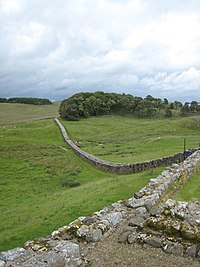
Hadrian’s Wall
(Vallum Hadriani), a fortification in Northern
England (viewed from
Vercovicium
)

Hadrian’s Gate
, in Antalya, southern Turkey was built to honour
Hadrian who visited the city in 130 CE.
Prior to Hadrian’s arrival on Great Britain there had been a major rebellion
in
Britannia
, spanning roughly two years (119–121).
It was here where in 122 he initiated the building of
Hadrian’s Wall
(the exact Latin name of which is unknown). The purpose of
the wall is academically debated. In 1893,
Haverfield
stated categorically that the Wall was a means of military
defence. This prevailing, early 20th century view was challenged by
Collingwood
[disambiguation
needed] in 1922. Since then, other points of view have been put
forwards; the wall has been seen as a marker to the limits of Romanitas,
as a monument to Hadrian to gain glory in lieu of military campaigns, as work to
keep the Army busy and prevent mutiny and waste through boredom, or to safeguard
the frontier province of Britannia, by preventing future small scale invasions
and unwanted immigration from the northern country of
Caledonia
(now modern day Scotland
). Caledonia was inhabited by tribes known to the Romans as
Caledonians
. Hadrian realized that the Caledonians would refuse to
cohabitate with the Romans. He also was aware that although Caledonia was
valuable, the harsh terrain and highlands made its conquest costly and
unprofitable for the Empire at large. Thus, he decided instead on building a
wall. Unlike the
Germanic limes
, built of wood palisades, the lack of suitable wood in the
area required a stone construction;
nevertheless, the Western third of the wall, from modern-day Carlisle to the
River Irthing, was built of turf because of the lack of suitable building stone.
This problem also led to the narrowing of the width of the wall, from the
original 12 feet to 7, saving masonry.
Hadrian is perhaps most famous for the construction of this wall whose ruins
still span many miles and to date bear his name. In many ways it represents
Hadrian’s will to improve and develop within the
Empire
,
rather than waging wars and conquering.
Under him, a shrine was erected in
York to Britain as
a Goddess, and coins were struck which introduced a female figure as the
personification of Britain, labeled
BRITANNIA
.
By the end of 122 he had concluded his visit to Britannia, and from there headed
south by sea to
Mauretania
.
Parthia
and Anatolia
In 123, he arrived in
Mauretania
where he personally led a campaign against local rebels.
However this visit was to be short, as reports came through that the Eastern
nation of Parthia
was again preparing for war, as a result Hadrian quickly headed eastwards. On
his journey east it is known that at some point he visited
Cyrene
during which he personally made available funds for the training of
the young men of well bred families for the Roman military. This might well have
been a stop off during his journey East. Cyrene had already benefited from his
generosity when he in 119 had provided funds for the rebuilding of public
buildings destroyed in the recent Jewish revolt.
When Hadrian arrived on the
Euphrates
,
he characteristically solved the problem through a negotiated settlement with
the Parthian king
Osroes I
. He then proceeded to check the Roman defenses before setting off
West along the coast of the
Black Sea
.
He probably spent the winter in
Nicomedia
,
the main city of
Bithynia
.
As Nicomedia had been hit by an earthquake only shortly prior to his stay,
Hadrian was generous in providing funds for rebuilding. Thanks to his generosity
he was acclaimed as the chief restorer of the province as a whole. It is more
than possible that Hadrian visited
Claudiopolis
and there espied the beautiful
Antinous
, a
young boy who was destined to become the emperor’s
beloved
. Sources say nothing about when Hadrian met Antinous, however, there
are depictions of Antinous that shows him as a young man of 20 or so. As this
was shortly before Antinous’s drowning in 130 Antinous would more likely have
been a youth of 13 or 14.
It is possible that Antinous may have been sent to Rome to be trained as
page
to serve the emperor and only gradually did he rise to the status of
imperial favorite.
After meeting Antinous, Hadrian traveled through
Anatolia
.
The route he took is uncertain. Various incidents are described such as his
founding of a city within Mysia, Hadrianutherae, after a successful boar hunt.
(The building of the city was probably more than a mere whim — lowly populated
wooded areas such as the location of the new city were already ripe for
development). Some historians dispute whether Hadrian did in fact commission the
city’s construction at all. At about this time, plans to build a temple in Asia
minor were written up. The new temple would be dedicated to Trajan and Hadrian
and built with dazzling white marble.
Greece
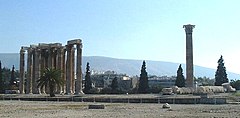
Temple of Zeus in Athens.
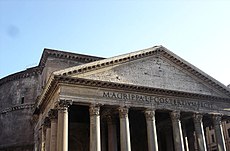
The
Pantheonn
was rebuilt by Hadrian.
The climax of this tour was the destination that the hellenophile Hadrian
must all along have had in mind, Greece. He arrived in the autumn of 124 in time
to participate in the
Eleusinian Mysteries
. By tradition at one stage in the ceremony the
initiates were supposed to carry arms but this was waived to avoid any risk to
the emperor among them. At the Athenians’ request he conducted a revision of
their constitution — among other things a new
phyle
(tribe) was
added bearing his name.
During the winter he toured the
Peloponnese
. His exact route is uncertain, however
Pausanias
reports of tell-tale signs, such as temples built by Hadrian and
the statue of the emperor built by the grateful citizens of
Epidaurus
in thanks to their “restorer”. He was especially generous to
Mantinea
which supports the theory that Antinous was in fact already
Hadrian’s lover because of the strong link between Mantinea and Antinous’s home
in Bithynia
.
By March 125, Hadrian had reached
Athens
presiding over the festival of
Dionysia
.
The building program that Hadrian initiated was substantial. Various rulers had
done work on building the
Temple of Olympian Zeus
— it was Hadrian who ensured that the job would be
finished. He also initiated the construction of several public buildings on his
own whim and even organized the building of an aqueduct.
Return
to Italy
On his return to Italy, Hadrian made a detour to
Sicily
. Coins
celebrate him as the restorer of the island though there is no record of what he
did to earn this accolade.
Back in Rome he was able to see for himself the completed work of rebuilding
the Pantheon
. Also completed by then was Hadrian’s villa nearby at
Tibur
a pleasant retreat by the
Sabine Hills
for whenever Rome became too much for him. At the beginning of
March 127 Hadrian set off for a tour of Italy. Once again, historians are able
to reconstruct his route by evidence of his hand-outs rather than the historical
records. For instance, in that year he restored the Picentine earth goddess
Cupra
in the town
of
Cupra Maritima
. At some unspecified time he improved the drainage of the
Fucine lake
. Less welcome than such largesse was his decision to divide
Italy into 4 regions under imperial legates with consular rank. Being
effectively reduced to the status of mere provinces did not go down well and
this innovation did not long outlive Hadrian.
Hadrian fell ill around this time, though the nature of his sickness is not
known. Whatever the illness was, it did not stop him from setting off in the
spring of 128 to visit
Africa
. His
arrival began with the good omen of rain ending a
drought
.
Along with his usual role as benefactor and restorer he found time to inspect
the troops and his speech to the troops survives to this day.
Hadrian returned to Italy in the summer of 128 but his stay was brief before
setting off on another tour that would last three years.
Greece,
Asia and Egypt
In September 128 Hadrian again attended the Eleusinian mysteries. This time
his visit to Greece seems to have concentrated on Athens and Sparta — the two
ancient rivals for dominance of Greece. Hadrian had played with the idea of
focusing his Greek revival round
Amphictyonic League
based in Delphi but he by now had decided on something
far grander. His new Panhellenion was going to be a council that would bring
together Greek cities wherever they might be found. The meeting place was to be
the new temple to Zeus in Athens. Having set in motion the preparations —
deciding whose claim to be a Greek city was genuine would in itself take time —
Hadrian set off for
Ephesus
.
In October 130, while Hadrian and his entourage were sailing on the
Nile,
Antinous
drowned, for unknown reasons, though accident, suicide, murder or religious
sacrifice have all been postulated. The emperor was grief stricken. He ordered
Antinous
deified, and cities were named after the boy, medals struck with his effigy, and
statues erected to him in all parts of the empire. Temples were built for his
worship in Bithynia, Mantineia in Arcadia, and Athens, festivals celebrated in
his honour and oracles delivered in his name. The city of
Antinopolis
or Antinoe was founded on the ruins of
Besa
where he died (Cassius Dio, LIX.11; Historia Augusta, Hadrian
Antinous (also Antinoüs or Antinoös;
Ancient Greek
:
Ἀντίνοος; 27 November, c. 111 – before 30 October 130) was a
Bithynian
Greek youth and a
favourite
of the Roman emperor
Hadrian
. He was
deified
after his death, although his exact
status in the Roman pantheon was uncertain.
Biography
Thorsten Opper in Hadrian: Empire and Conflict notes: “Hardly anything
is known of Antinous’ life, and the fact that our sources get more detailed the
later they are does not inspire confidence.” At an irreducible minimum he was
born to a Greek family in
Bithynion
–Claudiopolis,
in the
Roman province
of
Bithynia
in what is now north-west
Turkey
, and joined the entourage of the emperor
Hadrian at a young age, although nothing certain is known of how, when, or where
he and Hadrian met. He is frequently described and depicted as a beautiful boy
and youth. The relationship is believed to have been
sexual
.
Antinous drowned in the
Nile in October 130. The death was presented as an accident, “but it
was believed at the time that Antinous had been sacrificed or had sacrificed
himself,” and Hadrian “wept for him like a woman.” Hadrian went through the
process of
deifying
him soon afterwards, a process
previously exclusively reserved for imperial family members rather than friends
or lovers of non-Roman origin.
Commemoration: the cult of Antinous

Antinous (Museo
Pio-Clementino)
The grief of the emperor knew no bounds, causing the most extravagant
veneration to be paid to Antinous’ memory. Cities were founded in his name,
medals struck with his likeness, and cities throughout the east commissioned
godlike images of the dead youth for their shrines and sanctuaries. Following
the example of
Alexander
(who sought divine honours for his
beloved general,
Hephaestion
, when he died) Hadrian had Antinous
proclaimed a god. Temples were built for his worship in Bithynia,
Mantineia
in
Arcadia
, and
Athens
, festivals celebrated in his honour and
oracles
delivered in his name. The city of
Antinopolis
or Antinoe was founded on the site
of Hir-wer where he died (Dio
Cassius lix.11; Spartianus, “Hadrian”). One of Hadrian’s
attempts at extravagant remembrance failed, when the proposal to create a
constellation of Antinous
being lifted to
heaven by an eagle (the constellation
Aquila
) failed of adoption.
After deification
, Antinous was associated with and
depicted as the
Ancient Egyptian
god
Osiris
, associated with the rebirth of the
Nile. Antinous was also depicted as the Roman
Bacchus
, a god related to fertility, cutting
vine leaves. Antinous’s was the only non-imperial head ever to appear on the
coinage.

The
“Lansdowne
Antinous” was found at
Hadrian’s Villa
in 1769 (Fitzwilliam
Museum, Cambridge)
Worship, or at least acknowledgment, of the idealized Antinous was
widespread, although mainly outside the city of Rome. As a result, Antinous is
one of the best-preserved faces from the ancient world. Many busts, gems and
coins represent Antinous as the ideal type of youthful beauty, often with the
attributes of some special god. They include a colossal bust in the
Vatican
, a bust in the
Louvre
(the
Antinous Mondragone
), a
bas-relief
from the
Villa Albani
, a statue in the
Capitoline museum
(the so-called
Capitoline Antinous
, now accepted to be a
portrayal of Hermes
), another in
Berlin
, another in the
Lateran
and one in the
Fitzwilliam Museum
; and many more may be seen
in museums across Europe.
There are also statues in many archaeological museums in Greece including the
National Archaeological Museum in Athens, the archaeological museums of Patras,
Chalkis
and
Delphi
. Although these may well be idealised
images, they demonstrate what all contemporary writers described as Antinous’s
extraordinary beauty. Although many of the sculptures are instantly
recognizable, some offer significant variation in terms of the suppleness and
sensuality of the pose and features versus the rigidity and typical masculinity.
In 1998 the remains of the monumental tomb of Antinous, or a temple to him, were
discovered at
Hadrian’s Villa
.
Obelisk of Antinous on the Pincio Hill in Rome
(Obelisco Pinciano, Piazzale del Pincio, Roma) Made of Aswan pink granite
9.24 m. high, mounted on a modern plinth and surmounted by an ornamental star:
overall height 17.26 m. Commissioned by Hadrian and probably erected at the
Antinoeion of his villa in Tivoli. Moved to Rome by
Elagabalus
(218-222) to decorate the spina
of the Circus Varianus. Broken into three pieces, probably in the 6th century,
it was found in the 16th century near the Porta Maggiore. Moved to the
Palazzo Barberini
, then moved to the Vatican by
Pope Clement XIV
; finally erected on the
Pincian by
Pope Pius VII
in 1822. The four sides of the
obelisk are covered with reliefs and with hieroglyphs which, it cannot be
doubted, Hadrian composed. The reference to Hadrian’s wife Sabina being alive
shows that it dates from between Antinous’ death in 130 and Sabina’s in 136/7.
Greece,
Judaea, Illyricum
Hadrian’s movements subsequent to the founding of
Antinopolis
on October 30, 130 are obscure. Whether or not he returned to
Rome, he spent the winter of 131–32 in Athens and probably remained in Greece or
further East because of the Jewish rebellion which broke out in Judaea in 132
(see below). Inscriptions make it clear that he took the field in person against
the rebels with his army in 133; he then returned to Rome, probably in that year
and almost certainly (judging again from inscriptions) via
Illyricum
.
Second
Roman-Jewish War
In 130, Hadrian visited the ruins of
Jerusalem
,
in Judaea
, left
after the
First Roman-Jewish War
of 66–73. He rebuilt the city, renaming it
Aelia Capitolina
after himself and
Jupiter Capitolinus
, the chief Roman deity. A new temple dedicated to the
worship of
Jupiter
was built on the ruins of the old Jewish
Second Temple
, which had been destroyed in 70.
In addition, Hadrian abolished
circumcision
, which was considered by Romans and Greeks as a form of bodily
mutilation
and hence “barbaric”.
These anti-Jewish policies of Hadrian triggered in Judaea a massive Jewish
uprising, led by
Simon bar Kokhba
and
Akiba ben Joseph
. Following the outbreak of the revolt, Hadrian called his
general
Sextus Julius Severus
from
Britain
, and troops were brought from as far as the
Danube
. Roman
losses were very heavy, and it is believed that an entire legion, the
XXII Deiotariana
was destroyed.[45]
Indeed, Roman losses were so heavy that Hadrian’s report to the
Roman
Senate
omitted the customary salutation “I and the legions are well”.
However, Hadrian’s army eventually put down the rebellion in 135, after three
years of fighting. According to
Cassius
Dio
, during the war 580,000 Jews were killed, 50 fortified towns and 985
villages razed. The final battle took place in
Beitar
, a fortified city 10 km. southwest of Jerusalem. The city only fell
after a lengthy siege, and Hadrian only allowed the Jews to bury their dead
after a period of six days. According to the Babylonian
Talmud
,
after the war Hadrian continued the persecution of Jews. He attempted to root
out Judaism
,
which he saw as the cause of continuous rebellions, prohibited the
Torah
law, the
Hebrew calendar
and executed Judaic scholars (see
Ten
Martyrs
). The sacred scroll was ceremonially burned on the
Temple
Mount
. In an attempt to erase the memory of Judaea, he renamed the province
Syria Palaestina
(after the
Philistines
), and Jews were forbidden from entering its rededicated capital.
When Jewish sources mention Hadrian it is always with the epitaph “may his bones
be crushed” (שחיק עצמות or שחיק טמיא, the Aramaic equivalent),
an expression never used even with respect to
Vespasian
or Titus
who
destroyed the
Second Temple
.
Final
years
Succession
Hadrian spent the final years of his life at Rome. In 134, he took an
Imperial salutation
or the end of the Second Jewish War (which was not actually
concluded until the following year). In 136, he dedicated a new
Temple of Venus and Roma
on the former site of
Nero‘s
Golden House
.
About this time, suffering from poor health, he turned to the problem of the
succession. In 136 he adopted one of the ordinary
consuls
of that year, Lucius Ceionius Commodus, who took the name
Lucius Aelius Caesar
. He was both the stepson and son-in-law of Gaius
Avidius Nigrinus, one of the “four consulars” executed in 118, but was himself
in delicate health. Granted tribunician power and the governorship of
Pannonia
,
Aelius Caesar held a further consulship in 137, but died on January 1, 138.
Following the death of Aelius Caesar, Hadrian next adopted Titus Aurelius
Fulvus Boionius Arrius Antoninus (the future emperor
Antoninus Pius
), who had served as one of the four imperial legates of Italy
(a post created by Hadrian) and as
proconsul
of
Asia
. On 25 February 138 Antoninus received tribunician power and
imperium
.
Moreover, to ensure the future of the dynasty, Hadrian required Antoninus to
adopt both Lucius Ceionius Commodus (son of the deceased Aelius Caesar) and
Marcus Annius Verus (who was the grandson of an influential senator
of the same name
who had been Hadrian’s close friend; Annius was already
betrothed to Aelius Caesar’s daughter Ceionia Fabia). Hadrian’s precise
intentions in this arrangement are debatable. Though the consensus is that he
wanted Annius Verus (who would later become the Emperor
Marcus Aurelius
) to succeed Antoninus, it has also been argued that he
actually intended Ceionius Commodus, the son of his own adopted son, to succeed,
but was constrained to show favour simultaneously to Annius Verus because of his
strong connections to the Hispano-Narbonensian nexus of senatorial families of
which Hadrian himself was a part. It may well not have been Hadrian, but rather
Antoninus Pius — who was Annius Verus’s uncle – who advanced the latter to the
principal position. The fact that Annius would divorce Ceionia Fabia and
re-marry to Antoninus’ daughter Annia Faustina points in the same direction.
When he eventually became Emperor, Marcus Aurelius would co-opt Ceionius
Commodus as his co-Emperor (under the name of
Lucius
Verus
) on his own initiative.
The ancient sources present Hadrian’s last few years as marked by conflict
and unhappiness. The adoption of Aelius Caesar proved unpopular, not least with
Hadrian’s brother-in-law
Lucius Julius Ursus Servianus
and Servianus’ grandson Gnaeus Pedanius Fuscus
Salinator. Servianus, though now far too old, had stood in line of succession at
the beginning of the reign; Fuscus is said to have had designs on the imperial
power for himself, and in 137 he may have attempted a
coup
in which his grandfather was implicated. Whatever the truth, Hadrian ordered
that both be put to death.
Servianus is reported to have prayed before his execution that Hadrian would
“long for death but be unable to die”.
The prayer was fulfilled; as Hadrian suffered from his final, protracted
illness, he had to be prevented from
suicide
on
several occasions.
Death
Hadrian died in 138 on the tenth day of July, in his
villa
at Baiae
at age
62. The cause of death is believed to have been heart failure.
Dio Cassius
and the
Historia Augusta
record details of his failing health, and a study published
in 1980 drew attention to classical sculptures of Hadrian that show he had
diagonal earlobe creases – a characteristic associated with
coronary heart disease
.
Hadrian was buried first at
Puteoli
, near Baiae, on an estate which had once belonged to
Cicero
. Soon
after, his remains were transferred to Rome and buried in the Gardens of Domitia,
close by the almost-complete mausoleum. Upon the completion of the
Tomb of Hadrian
in Rome
in 139 by his successor
Antoninus Pius
, his body was cremated, and his ashes were placed there
together with those of his wife
Vibia
Sabina
and his first adopted son,
Lucius Aelius
, who also died in 138. Antoninus also had him deified in 139
and given a
temple
on the
Campus Martius
.
Poem
by Hadriann
According to the
Historia Augusta
Hadrian composed shortly before his death the following
poem:
-
Animula, vagula, blandula
-
Hospes comesque corporis
-
Quae nunc abibis in loca
-
Pallidula, rigida, nudula,
-
Nec, ut soles, dabis iocos…
-
-
-
P. Aelius Hadrianus Imp.
-
Little soul, roamer and charmerr
-
Body’s guest and companion
-
Into what places will you now depart
-
Pale, stiff, and nude
-
An end to all your jokes…
|






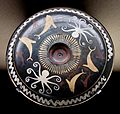

_01.jpg/117px-Pátera_ibera_de_Perotito_(M.A.N._1917-39-1)_01.jpg)






 sometimes
sometimes Publius Aelius Hadrianus
Publius Aelius Hadrianus 









